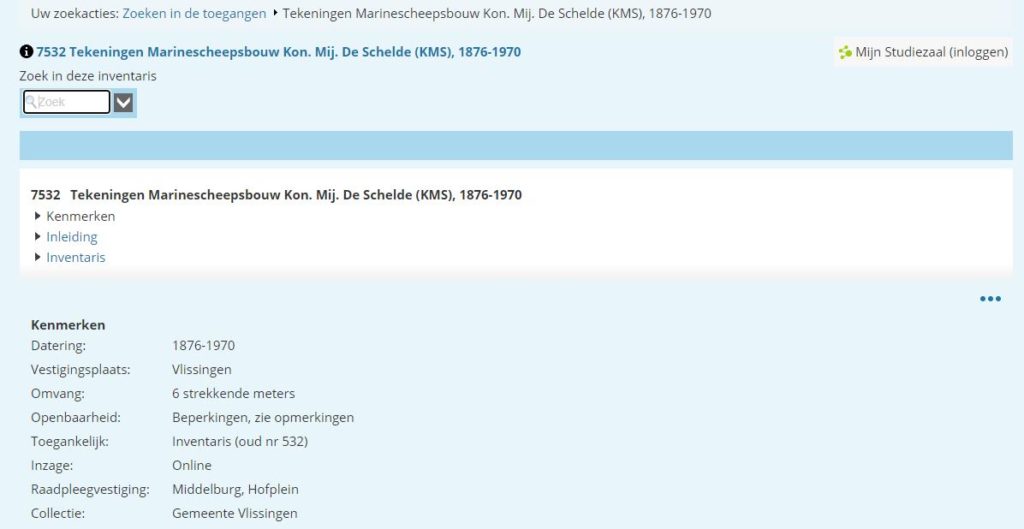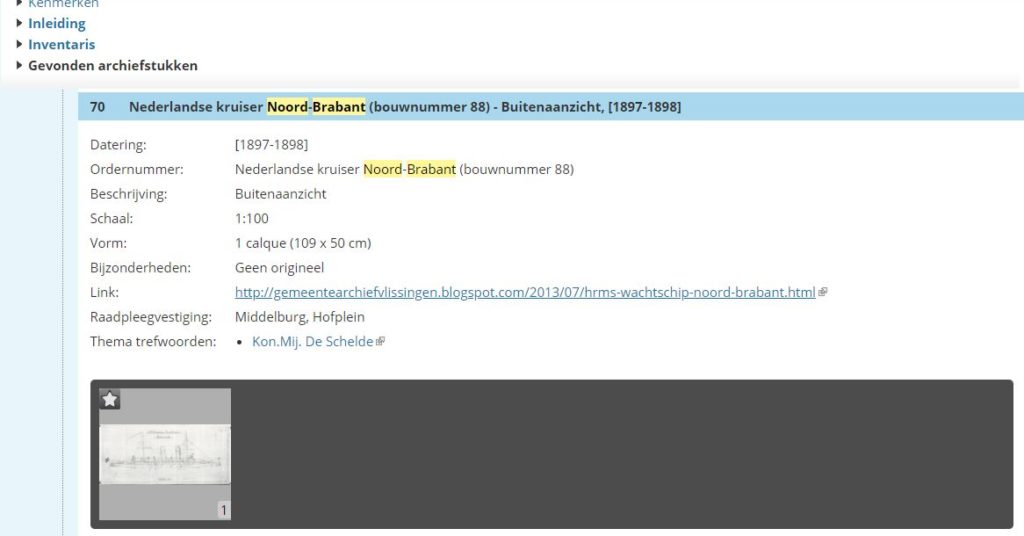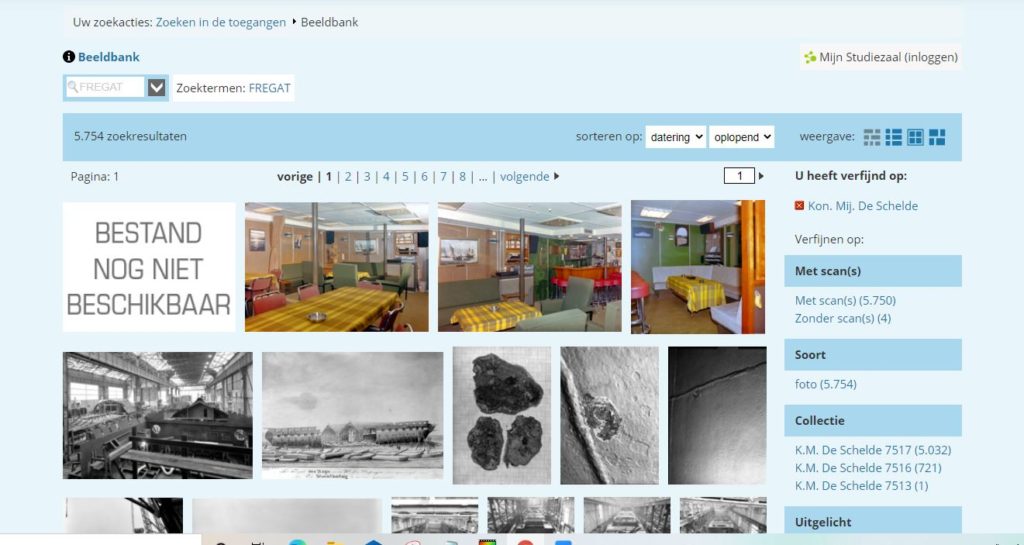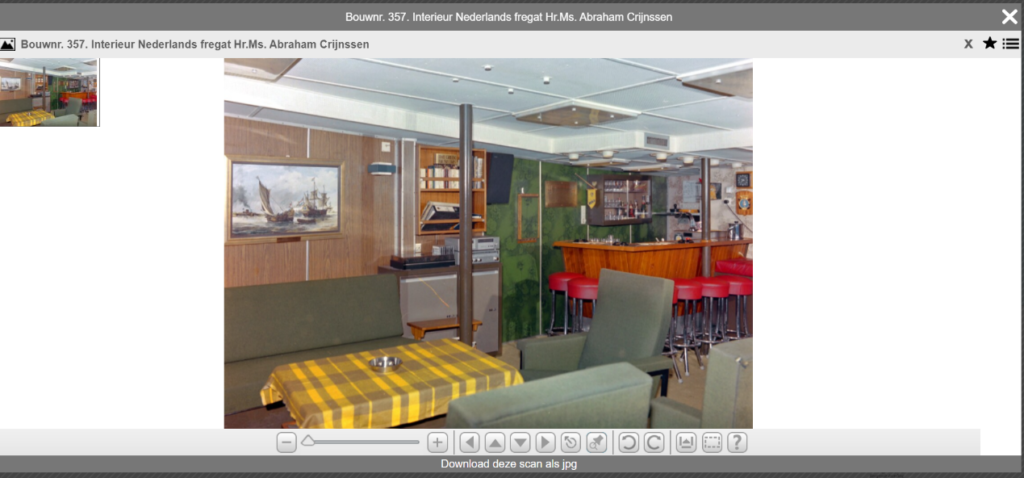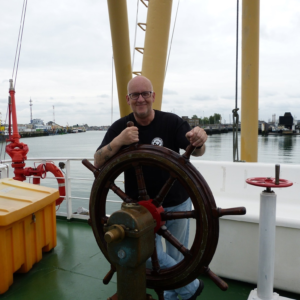 Thank you to Ron van Maanen for this excellent blogpost about the archives for Kon. Mij. De Schelde.
Thank you to Ron van Maanen for this excellent blogpost about the archives for Kon. Mij. De Schelde.
Ron was born in The Hague, Netherlands (1958) on a distance of just 7 kilometers from the North Sea. Since my childhood I was attracted by the sea and ships, perhaps because both my grandfathers and uncles were in fact sailors. As a teenager he went with his dad and also sometimes alone to the fishing harbour of Scheveningen, wandering in the harbour of Rotterdam and dreaming of a life as a sailor on a tug of tramper while sitting on the riverbank of the Nieuwe Waterweg, Hoek van Holland. It all turned out differently. Budget cuts and an economic crisis prevented a career with the Royal Netherlands Navy and he was drawn for history studies. After his military service in the Army, Ron started to work in the archives. Within a year, while actively working in the historical archives, he did his first discovery about a Dutch warship whose fate had until then been unknown.
He never quit working in archives and obtained all available diplomas and certifications. After working on several archives of departments including the Naval Staff (archives of the Royal Netherlands Navy) and archives of various cities we moved to Vlissingen in 2012. Vlissingen is a city alongside the bank of the river Schelde, a very busy passage to Dutch and Belgian harbours.
At the same time Ron became responsible for the archive for the Shipyard Kon. Mij. De Schelde (Royal Scheldt Shipyards). It resulted in many articles, exhibitions and finally a book with Tobias van Gent about the submarines built at Vlissingen. In 2020, the large archives dealing the Schelde shipyard were handed over to the Zeeuws Archief which became Ron’s new employer. Since then several notes were published on the weblog of this archive dealing with the maritime history of Vlissingen.
Ron works with his son (who is a marine engineer) on own weblog http://warshipsresearch.blogspot.com/ dealing with maritime history since the 16th Century. My special interests are whaling, tugs and 20th Century navies (including never realized designs). They have also co-authored a book Nordic Sails-History & development of working sail in North & Northwest-Europe to be published in 2021. The book presents a broad outline of the history and development of working sail in Northern and Northwestern Europe in the last centuries including the new interests nowadays for using wind energy for ships again.
A Short History of the Shipyard and Predecessors
The shipyard of De Konnklijke Maatschappij De Schelde (Royal Company De Schelde) was founded using what was left of the facilities belonging to the former navy yard at Vlissingen, Netherlands.
In 1609 Prince Maurits of Nassau gave the order to dig out a harbour where the warships could stay during the winter and be maintained. A small canal connected this harbour (called Dokhaven) with the Scheldt river which gave directly entrance to the North Sea.1 A result was a strategic position for the naval base with all the benefits but also a vulnerable position for attacks over sea. At first she was maintained by the admiralty of Zealand, and then from 1813 until 1868 by the Koninklijke Marine (Royal Netherlands Navy). In 1809 invaded British forces the Netherlands in an attempt to end the threat of the Napoleonic shipyards at Antwerp, Belgium. The town of Vlissingen was bombarded by the Royal Navy with guns and rockets. A frigate and a ship of the line were captured and which became respectively HM Ships Laurel and Chatham. 2
In 1704-1705 was a small dry dock graven nowadays known as the Dok van Perry after her designer the British navy officer John Perry. 3 Later were dry docks on the so-called Island yard dug. A few years ago were the remaining docking registers of the shipyard Kon. Mij. De Schelde over the period 1918-1977 found back, digitized and to be downloaded. 4 The registers gave a good impression which ships were where and when docked. There were however a lot of problems with the dock van Perry and most of the time it could not be used. To compensate the maintenance was a special quay made suitable for corvettes and smaller ships. 5
Since 1815 were around the Dokhaven in the centre of the town 5 slipways available, the remains of the last two large slips used until the 1970s were in 2020 more or less demolished during the preparations for new building of flats. The smaller slips were then more as a century ago broken up.6 To store the equipment was a large available warehouse built in 1767 to replace one destroyed by fire/ It was used until 1969.7 A former church was first used as warehouse and became later part of the foundry. 8

The small covered slips at the Dokhaven after 1875
Zeeuws Archief, Kon. Mij. De Schelde, collectie 7513, nr 5974
The 19th Century naval yard at Vlissingen was not the largest of the Dutch naval shipyards but probably the most sophisticated. There were the best of the engineers working, the technical counselor of the minister and head engineer Lambertus Karel Turk had here his head office and innovative projects were undertaken. Among these projects were the conversion of the sailing frigate De Rijn into a paddle wheel steam frigate, and (and then back) and the conversion of old sailing ships into floating batteries. 9 There was contact with English naval engineers and Dutch naval officers sailing over the whole world sent reports of their visits supplying (technical) details about what elsewhere was going on. However in the early 1860s the Dutch government decided to decrease again the number of shipyards and to concentrate in the provinces North and South Holland, meaning the end for the yard at Vlissingen. Naval head engineer and chief counselor of the Dutch minister for navy Bruno Joannes Tideman proposed to found a modern shipyard annex machine plant on this location but without success. He introduced for instance the Froude ship test tank in the Netherlands. In 1868 were the‘doors’closed and part of the buildings demolished. The archive of the navy yard is available for research at the Zeeuws Archief at Middelburg.10.
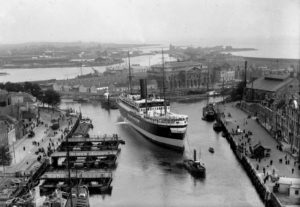
The merchant ship Ecuador preparing for departure on 11 October 1915
Zeeuws Archief, Kon. Mij. De Schelde, collectie 7513, nr 5974
For the next few years the area was neglected except for storage of goods and docking merchant ships in the dry dock supervised by the town Vlissingen. The Dutch shipbuilder Arie Smit with support of Tideman asked the Dutch cabinet for permission to found a new shipyard. This request was granted and in 1875 was the yard founded. In advance were ships to be newly built or repaired just like boilers and engines. The first object she built was a large pontoon for transporting boilers and engines. This was in fact yard number one, but nowadays the fishing sloop De Zeeuw is considered to be number one. In 2014 was an unknown drawing of the pontoon discovered. pontoon 11 In the 20th Century was decided to built also bridges (since the 1920s), aircraft (1930s-1940) and directly after the Second World War also buses. As a result of an increasing demand for her products was more personnel needed. From a handful in the beginning to several thousands, for in stance 4,600 in 1951.
Except for the hundreds of merchant ships were warships built for the Royal Netherlands Navy and just one warship abroad. At Vlissingen was the first Dutch submarine Hr.Ms. O 1 built between 1904-1906, followed by several others for the Royal Netherlands. 12 There was one exception namely the Polish submarine Orzel. 13. The latter became famous escaping from the invaded Poland and operating from British harbours until she disappeared in 1940 and never was traced. A fate she shares with the Dutch submarine Hr. Ms O 13 also built at Vlissingen and operating from Dundee. Except for American and Dutch designs was one time a British Vickers design used for the Dutch submarines. During a short period there was a battery plant 14 in Vlissingen. After the Second World War was the new building of warships divided over several Dutch shipyards and were at Vlissingen destroyers and frigates (the Dutch type Leander-class) completed but no longer submarines. However nowadays is Damen Schelde Naval Shipbuilding one of the competitors for building new submarines replacing the Walrus-class diesel submarines. For that purpose she cooperates with the Swedish Saab Kockum BS firm.
The world wide competition between shipyards caused a huge crisis forcing to cooperate. The De Schelde succeeding in surviving the 1970s and 1980s when it became the main shipbuilder of Dutch warships including a large number of frigates, but became part of the Rijn Schelde Verolme concern which went bankrupt in 1983. Since 2000 it is part of the Damen Shipyards Group under the new name Damen Schelde Naval Shipbuilding. The ships are now for the main part built at Galatz, Romania but still partly fitted out and completed at Vlissingen.
The British-Scottish connection
Moving beyond Arie Smit to take a better look as his staff and we will discover the connections with shipbuilding United Kingdom and Scotland. Three men worked together at the shipyard for decades until their death. Main engineer for the machine plant was the self-taught Scot Hamilton Martin. 15, 16. He was self-taught, and was theinventor of a sextuple expansion steam engine. This engine still exists and was a few years ago restored by naval mechanics in training at the Maritiem Instituut de Ruyter at Vlissingen. Chief shipbuilding engineer Jacob Janszen jr. was responsible for the shipbuilding department. He received a practical education at the navy yard at Amsterdam, and in the early 1870s was sent to the Fairfield shipyard in Scotland to supervise the building of steel construction passenger ships for Dutch companies. Returning in 1874 he was one of the few available experienced Dutch naval engineers to be enlisted by the new shipyard. Janszen and Tideman, had both worked at the naval shipyard at Amsterdam. The last but not least third men was the experienced financial director Jos van Raalte, whose nephew was the Dutch consul at Glasgow.
Fairfield became financially interested in the Dutch shipyard and both shipyards worked together to obtain an order for a Dutch battle cruiser just before the First World War. Due to the outbreak of the war that ship was never built. In the early years, second hand tools and machinery were purchased in the United Kingdom and brought to the Netherlands; for example in 1884 from a Scottish plant.17

Water tube boilers for the cruiser Hr.Ms. Java 10 May 1922
Zeeuws Archief, Kon. Mij. De Schelde, collectie 7513, nr 1183
In the beginning were the boilers lacking the knowledge and experience bought abroad but this quickly changed thanks to Hamilton. The engines and boilers department became so important that she kept the shipyard in the early years going on while the shipbuilding department was a less success. This was caused by lacking orders and huge financial losses on the ships, which were often delivered too late or while too less was asked for the order.
The shipyard’s archive is divided into several parts, and is stored at the Zeeuws Archive, Middleburg since 1 January 2020. You can consult each catalogue through a single search screen. The website is in Dutch, and although the website’s text can be switched to English, searches have to be written in Dutch unless they are a ships’ name.
The archive of the board
The backbone of the shipyard archive is the part with the minutes of the meetings of the board and the shareholders and their correspondence of the board. 18 Further more this archive contains the accountancy and correspondence (including the contracts) dealing with obtaining and realizing orders for building or repairing of ships, boilers and engines. There are just a few records dealing with the aircraft, parts for aircraft and buses. The letters sent by the financial director Jos van Raalte are digitized.19 It’s a combination of Dutch and English letters written between 1879-1909 to contact within the Netherlands and abroad as far as South America the Far East.20
Except for the Dutch market were also ships built or repaired for the foreign market. One very remarkable order was the modernization of a still existing and even in actual service Russian submarine salvage vessel Kommuna. There were several ships built for Russia but also for Greece, the United Kingdom and so on. To get the most update impression of the ships built by the shipyard you have to consult The ships we built published in 2018 by Guns@Home (www.gunsathome.nl), in which all ships are described built within the period 1875-2018. A second possibility is to consult the website of Damen Schelde Naval Shipbuilding. The item titled Memoriaal van de Marine catalogued as inventory number 1804 21 is of major interest and a ‘must have’ for everybody interested in maritime history. It is a book published by Tideman between 1876-1880 and describes in detail types of Dutch warships, guns, boats rigging and other ship parts with illustrations. It’s digitized and can be downloaded page by page. f you sent an email to the archive it is possible to obtain a PDF of the whole.
The archive of the engine plant 1876-1938
The shipyard started manufacturing – or more accurately, assembling marine boilers and engines. For that purpose was a plant built, partly still existing nowadays. 22 Almost all drawings before 1910 are still available. After 1910 very few of the drawings or records are available. The good news is that the preserved drawings are preserved, digitized and which can be downloaded without any expenses. There are indeed magnificent made drawings available. 23 To give an example, there is a drawing of the engines of the Dutch protected cruiser Hr.Ms. Noord-Brabant and shown on an international exhibition at Paris, France.
The collection of the drawing room for warships 1876-1970
Drawings are available for nearly all ships built for the Royal Netherlands Navy and the famous Polish submarine Orzel. The number of drawings available per ship varies widely, from one to dozen. Also, there are many drawings from the Second World War when Germans forced the Dutch shipbuilding industry to support the war effort, though very few ships were actually completed.
Sadly, none of the warships which were to built with the help of Fairfield before the outbreak of the First World War or the battle cruisers before the outbreak of the Second World War have remaining drawings. However, there are drawings of submarines while the first Dutch submarine Hr.Ms. O 1was built at Vlissingen and of the cruiser Hr.Ms. Java sunk in 1942 during the Battle of Java Sea with her Australian, British, Dutch and American colleagues.
The Process for Searching the Database
If you use the above mentioned url you have to do some steps to get a result. These steps are following:
Step 1
You will first have to go the right url dealing with this archive: 24.
Step 2
The next step is to type in the search screen (left above) a term or a name. In this case I chose for the name Noord-Brabant. Within the Koninklijke Marine served in the 20th Century two ships with this name, a protected cruiser (kruiser) and a submarine chaser which was in fact a destroyer (onderzeebootjager).
Step 3
I choose to look for drawings of the protected cruiser in my next step. The black dot before an inventory number and a description of the drawing means that there is a scan available. So click on the sentence behind the number, for instance No. 7.
Step 4
In step 4 you get this screen. Now click on the drawing.
Step 5
This screen allows you to download the drawing by clicking on the sentence on the bottom ‘download deze scan as jpg’and the download starts automatically. Probably the drawing is to find back in the map downloads on your computer.
In this case, the result is a free-use image (nearly 37MB) as shown below. Of course, we ask is that when you use the archive that you identify the source
The collection of the drawing room for the merchant ships 25
The major parts of the preserved drawings were of merchant ships built since 1875. Several thousands were digitized until there was no money available to finish the project. In 2019 the project stopped until new funds are found. There around 6,000 drawings to be digitized. This collection contains drawings of Dutch passenger-cargo ships, Russian fish carriers, British dredgers, German icebreaker, cargo ships for the Black Star Line of Ghana and so on. For downloading of a drawing see the process described under the collection with drawings of the warships 1876-1970
The collection with drawings of the buildings 1911-1966
Unfortunately, these records are not currently available as a digital resources. It contains all the buildings, slips, roads and so on which are broken up or transferred to the Dutch town Vlissingen. Some of the buildings like the engine plant, carpentry factory and the main office of the shipyards still exists.26
The collection of plans for ships, engines and boilers 1881-1950
Every time when the shipyard wanted to obtain an order drawings and plans were made. Several dozen of these plans were preserved and catalogued, with a focus on digitizing and uploading those plans related to the Koninklijke Marine. For downloading of a drawing see the process described under the collection with drawings of the warships 1876-1970. 27
Th example below is a description of the engines fort he steam engines for the Dutch protected cruiser Hr.Ms. Noord-Brabant. If you click on the url you get to see is a series of scans which had to be downloaded individually. 28
The photo collections
There were more as 100,000 photos existing dating from end 19th Century until 1970 and beyond. More as 48,000 photos are uploaded to the internet and a vast majority can be downloaded. A general search screen is the best manner to search for one ship by name or a term translated into Dutch like destroyer becomes torpedobootjager and submarine becomes onderzeeboot. 29
Step 1
To give an example of what you van find I used the term fregat (=frigate), and this are the results are 5.912 with and 41 without a scan 30
Step 2
I just chose the second coured photograph I saw. If you want to specify your search, type behind the term ‘fregat’for instance the name of a ship, like Abraham Crijnssen, otherwise you get all photographs with the term fregat. What you now have to do is click with your mouse on the photo.
Step 3
This is in fact the download screen. You have to click on the sentence ‘download deze scan as jpg’ and automatically the download starts.
Interior of the Dutch frigate Hr.Ms. Abraham Crijnssen
Step 4
Search on your own computer fort he map where the photo is stored, probably the map downloads.
Maritime historical blogposts published on the weblog of the Zeeuws Archive, Middelburg, Netherlands
On the weblog of the Zeeuws Archive are several blogposts published dealing with the shipyard De Kon. Mij. De Schelde, her predecessors and the maritime history of the province Zeeland especially the harbour and naval base of Vlissingen. The blogs are written in Dutch but google translator can be of great help. Because these posts are not well known outside the Netherlands I made a small description of the content and the corresponding urls. There are several books published dealing with the history of the shipyard Kon. Mij. De Schelde at Vlissingen, except for the one dealing with the ships built by her, all in Dutch language. The wikipedia post in English is a stub, for the Dutch version see on. In the above mentioned blogposts are sometimes links available referring to the archives giving background for the documents you will find. 31.
Holdings related to other historical naval events
In 1588 was Spanish Armada underway to attack and invade the United Kingdom defeated by the Royal Navy and weather. What often is forgotten is the support of Dutch warships. Some Spanish galleons ended in Dutch waters. Part of the war flag of the San Mateo still exists. 32
The United Kingdom and the Netherlands sharing a long maritime history sometimes as allies sometimes as enemies. There were four so-called Anglo-Dutch wars. In the first three played Michiel Adriaanszoon de Ruyter a role. He is the most famous Dutch admiral and well known in the United Kingdom for the raid on the Medway in 1667. It is for centuries tradition to name a ship in the Royal Netherlands Navy after him. Many of these ships were built at Vlissingen.33 When the fourth broke out the Dutch navy was reduced to a shadow of the past. Quickly started newbuilding of warships also at the Admiralty yard at Vlissingen. 34
After the Napoleonic wars was the Dutch navy reduced to a handful of (aged sometimes even useless) ships. Some ships of the line, frigates and so on were handed over by the French. Further more was British frigate HMS Diana bought and recommissioned as Zr.Ms. Diana. She participated in the Anglo-Dutch attack on Algiers in 1816. There is a wonderful drawing of her available in the archive. 35
A naval base needs guard ships to protect herself and to execute tasks like training and patrol duties in the surrounding area 36. After closing the navy yard at Vlissingen in 1868 became the guard ships smaller and smaller and sometimes even absent.37 Not every sailor had a wonderful life 38 on board, some died other disappeared. Strangely enough was after 1868 the harbour of Vlissingen with a large government capital increased without sufficient protection and despite the important shipping lane to Antwerp, Belgium.
In 1866 panic broke out in the Netherlands when the Peruvian armoured frigate Independencia suddenly appeared on the Scheldt River. 39
The former Dutch protected cruiser Hr.Ms. Noord-Brabant nearly became an institute at Vlissingen for juvenile children controlled by the government due to their bad behaviour. Later she became a guard ship annex training ship until she was scuttled by her own crew in 1940 during the German invasion. 40, 41
In 1904-1905 was the Russian fleet nearly complete destroyed by the Japanese fleet. Afterwards decided Japan to a diplomatic by sending a couple of warships to the USA and West-Europe including the Netherlands. mission 42
In 1909 built the shipyard Kon. Mij. De Schelde a test station for the Royal Netherlands Navy to experiment with all kind of coal in the Dutch East Indies. 43
In 1921 sunk the Dutch minelayer Hr.Ms. Hydra on the Scheldt River. Of her salvage is a complete photo album preserved. 44
The famous Dutch passenger ship Willem Ruys later the ill-fated Achille Lauro was in 1939 to be fitted out as an auxiliary cruiser especially to act against the enemy merchant shipping. 45
The battle in the Java Sea in 1942 was a disaster for the Allied ABSA squadron commanded by the Dutch rear admiral Karel Doorman. More as 2.300 Allied sailors died including 915 Dutch. One of the Dutch sailors was Hendrik on board of the Vlissingen built cruiser Hr.Ms. Java. Stofberg 46
In 1942 the British Indies minesweeper HMIS Bengal and the Dutch tanker Ondina were involved in a battle with two Japanese auxiliary cruisers, resulting in a Japanese defeat. In the 1950s pupils corresponded with the crew of the Ondina make it possible to get an impression of the daily life on board. 47
The Royal Netherlands Navy used several designs of British warships for instance a Yarrow design of building her Admiralen-class destroyers. One was built at Vlissingen namely the Hr.Ms. De Ruyter later renamed Van Ghent. The last best known British design is of the Leander-class frigates from the 1960s, in Dutch service the Van Speijk-class, all sold to the Indonesia and apparently still existing. Three of the six were built by De Schelde. Magnificent seaworthy ships and I had the honor to make a small trip of three days on the Hr.Ms. Isaac Sweers in a winter storm December 1985.48
Slavery
The Netherlands was just like other West European countries involved in the trans atlantic slavery. In Middelburg where the Middelburgsche Commercie Company was located is a walking route to look for the remains of this period. The archive of the Middelburgsche Commercie Compagnie at Middelburg is of international importance for studying the trans Atlantic slavery. The archive of this company is stored at the Zeeuws Archief, digitized and there is also a weblog dealing with the voyage of one slaver. 49, 50
Harbours and merchant shipping
Nowadays is the oyster fishery still important for the Dutch province Zealand. In 1885, the shipyard built two oyster fishing vessels active off the coast of North Holland and the former island of Wieringen. 51
When a ship is wrecked surviving crew members are bidding for help. Rescue boats are playing an important role like in 1906 for the German cargo ship Hugo&Clara. 52
Since 1926 was in the harbour of Vlissingen a coal bunker station (later also oil) used by Dutch and foreign merchant shipping. 53
With the Second World War still going on decided the Dutch cabinet in the United Kingdom to make preparations to rebuilt the Dutch merchant fleet which suffered badly. However the order of several cargo ships was cancelled. 54
In 1947 was the harbour of Vlissingen temporarily used for exporting Italian fruit to the United Kingdom. 55
In 1952 was temporarily Norwegian whale oil stored in the harbour of Vlissingen. 56
The cargo ship Contessa of Honduras was in 1957 docked in the graven dock on the so-called Island shipyard in Vlissingen. 57
The harbour of Vlissingen played also an role in the export of potatoes 58 for instance to Sri Lanka in 1961.
Since 1964 was Vlissingen the Dutch transit port for wood used by the Dutch paper industry and later also for Germany imported from Finland, Canada, South America and so on. 59
Except for wood became Vlissingen since 1964 more and more the Dutch harbour for import of wool coming from Argentina, Australia and New Zealand. 60
References
References
- https://www.zeeuwsarchief.nl/blog/de-marinesluis-van-vlissingen/
- https://www.zeeuwsarchief.nl/blog/de-vlissingse-admiraliteitswerf/,https://www.zeeuwsarchief.nl/blog/engelse-expeditie-in-1809/
- https://www.zeeuwsarchief.nl/blog/het-kleine-droogdokje-of-het-dokje-van-perry/
- https://www.zeeuwsarchief.nl/blog/de-dokregisters-van-de-kon-mij-de-schelde-1918-1977/
- https://www.zeeuwsarchief.nl/blog/de-vlissingse-kielkade-of-kielplaats-uit-1780/
- https://www.zeeuwsarchief.nl/blog/de-kappen-op-de-marinewerf-en-scheldewerf/
- https://www.zeeuwsarchief.nl/blog/het-arsenaal-of-s-lands-zeemagazijn-te-vlissingen-1767-1969/
- https://www.zeeuwsarchief.nl/blog/de-voormalige-oostkerk-in-vlissingen/
- https://www.zeeuwsarchief.nl/blog/fregat-den-rhijn-in-beeld-als-zeil-en-als-stoomschip/
- https://www.zeeuwsarchief.nl/blog/schepen-koninklijke-marine-gebouwd-te-vlissingen-in-1817-1861/
- https://www.zeeuwsarchief.nl/blog/onbekende-tekening-onthult-dat-de-schelde-als-eerste-een-ponton-bouwde/
- https://www.zeeuwsarchief.nl/blog/onderzeebootbouw-in-vlissingen-tussen-1904-en-1940/
- https://www.zeeuwsarchief.nl/blog/een-poolse-adelaar-still-on-patrol/
- https://www.zeeuwsarchief.nl/blog/accus-voor-onderzeeboten-uit-vlissingse-accumulatorenfabriek-1921-1934/
- https://www.zeeuwsarchief.nl/blog/schots-ingenieur-william-hamilton-martin-maakte-de-schelde-groot/
- https://www.zeeuwsarchief.nl/blog/stenen-documenten-het-graf-van-ingenieur-martin/
- https://www.zeeuwsarchief.nl/blog/boren-schaafbanken-en-hamers-de-bedrijfsinventaris-van-de-schelde-in-1875-1884/
- https://hdl.handle.net/21.12113/26A7030139CD423196A3E7125474A997
- https://hdl.handle.net/21.12113/70A432E0E0534287BD9E870A98C2E834
- https://www.zeeuwsarchief.nl/blog/de-brievenboeken-van-jos-van-raalte-directeur-van-de-schelde/
- https://hdl.handle.net/21.12113/FFA6AE138F7B4874BA75731B398887DE
- https://www.zeeuwsarchief.nl/blog/de-machinefabriek-en-ketelmakerij-1876/
- https://hdl.handle.net/21.12113/3C65E73EF5D34BC4A484516E962A764A
- https://hdl.handle.net/21.12113/A4687B9BF5AC43C5ADC516F80023CE33
- https://hdl.handle.net/21.12113/A2A2C5486C0742BA8E7F9D5A846EF9EB
- https://hdl.handle.net/21.12113/926902EF67514C20B5AEBA8D25014401
- https://hdl.handle.net/21.12113/5E36CB92468E482AA20922C947B31398
- https://hdl.handle.net/21.12113/BBF7DE7E134D4E6799D2FC366A654511
- https://www.zeeuwsarchief.nl/onderzoek-het-zelf/archief/?mivast=239&mizig=261&miadt=239&milang=nl&misort=unitdate%7Casc&mif4=Kon.%20Mij.%20De%20Schelde&miview=gal
- https://www.zeeuwsarchief.nl/onderzoek-het-zelf/archief/?mivast=239&miadt=239&mizig=261&miview=gal&milang=nl&micols=1&misort=unitdate%7Casc&mif4=Kon.%20Mij.%20De%20Schelde&mizk_alle=FREGAT
- https://nl.wikipedia.org/wiki/Damen_Schelde_Naval_Shipbuilding
- https://www.zeeuwsarchief.nl/blog/vlissingen-en-de-wimpel-uit-de-spaanse-armada-van-1588/
- https://www.zeeuwsarchief.nl/blog/identificatie-van-linieschip-goes-gebouwd-in-1779-1781-te-vlissingen/
- https://www.zeeuwsarchief.nl/blog/200-jaar-marineschepen-de-ruyter/
- https://www.zeeuwsarchief.nl/blog/het-fregat-hr-ms-diana-en-de-bevrijding-van-de-christenslaven-in-1816/
- https://www.zeeuwsarchief.nl/blog/wachtschepen-van-de-marine-in-vlissingen-in-1800-1850/
- https://www.zeeuwsarchief.nl/blog/wachtschepen-van-de-marine-in-vlissingen-in-1850-1900/
- https://www.zeeuwsarchief.nl/blog/van-overlijdensakte-naar-een-ontploffing-en-een-ontsnapping-van-wachtschip-maas/
- https://www.zeeuwsarchief.nl/blog/bijna-zeeslag-bij-terneuzen-in-1866/
- https://www.zeeuwsarchief.nl/blog/voormalig-marineschip-bestemd-tot-inrichting-voor-minderjarige-tbsers/
- https://www.zeeuwsarchief.nl/blog/hr-ms-wachtschip-noord-brabant-1926-1940/
- https://www.zeeuwsarchief.nl/blog/japanse-oorlogsschepen-bezochten-vlissingen-in-1907/
- https://www.zeeuwsarchief.nl/blog/kolenproefstation-voor-nederlands-indie/
- https://www.zeeuwsarchief.nl/blog/berging-van-de-mijnenlegger-hydra-in-1921-in-een-fotoalbum-vastgelegd/
- https://www.zeeuwsarchief.nl/blog/passagiersschip-willem-ruys-ooit-beoogd-als-oorlogsschip/
- https://www.zeeuwsarchief.nl/blog/vlissingse-marineman-stofberg-sneuvelde-bij-de-slag-in-de-javazee-in-1942/
- https://www.zeeuwsarchief.nl/blog/vlissingse-leerlingen-corresponderen-met-nederlandse-tanker-en-oorlogsheld-ondina/
- https://www.zeeuwsarchief.nl/blog/torpedobootjager-hr-ms-de-ruyter-van-ghent/
- https://www.zeeuwsarchief.nl/blog/tres-hombres-slavernijroute-middelburg/
- https://www.zeeuwsarchief.nl/blog/vandaag-258-jaar-geleden-aan-boord-van-de-eenigheid/
- https://www.zeeuwsarchief.nl/blog/bouw-van-de-amsteldiep-en-mossel-in-1885-voor-de-maatschappij-oesterteelt-amsteldiep/
- https://www.zeeuwsarchief.nl/blog/vlissingse-roeiers-redden-duitse-schipbreukelingen-in-1906/
- https://www.zeeuwsarchief.nl/blog/zwart-goud-en-de-steenkolen-handels-vereeniging-in-vlissingen/
- https://www.zeeuwsarchief.nl/blog/de-onbekende-dido-klasse-de-geannuleerde-bouworders-van-de-schelde-in-1944-1945/
- https://www.zeeuwsarchief.nl/blog/italiaans-fruit-via-vlissingen-naar-engeland-in-1947/
- https://www.zeeuwsarchief.nl/blog/walvistraan-in-de-haven-van-vlissingen/
- https://www.zeeuwsarchief.nl/blog/hondurees-vrachtschip-contessa-in-het-vlissingse-eilanddok-in-1957/
- https://www.zeeuwsarchief.nl/blog/nederlandse-aardappelen-voor-sri-lanka-in-1961/
- https://www.zeeuwsarchief.nl/blog/hoe-vlissingen-een-houthaven-werd-in-1964/
- https://www.zeeuwsarchief.nl/blog/vlissingen-stapelhaven-voor-wol-vanaf-1964/



